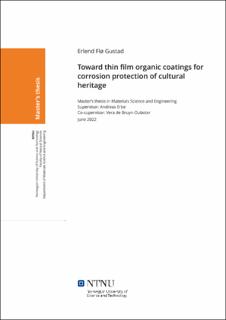| dc.description.abstract | Korrosjon av metall utgjør en betydelig utfordring for bevaring av museumsgjenstander, og ved
Ringve / Rockheim musikkmuseum i Trondheim er det observert korrosjonsskader p˚a flere musikkinstrumenter. Korrosjon av jern p˚a et taffelpiano, en mandolinbanjo og en indisk surbahar utforskes i denne studien. Korrosjonsbeskyttelse basert p˚a organiske tynnfilmer er ansett som en mulig løsning med stort potensial. I denne studien undersøkes tre forskjellige tynnfilms beleggsystemer
basert p˚a oktadecyltrimethoksysilan (ODTMS), oktadecylfosfonsyre (ODPA) og stearinsyre (SA)
p˚a substrater av st˚al p˚aført fra organiske løsninger av etanol, isopropanol og toluen. Overflatemodifikasjon har blitt utforsket ved FT-IR-spektroskopi og røntgen-fotoelektron-spektroskopi. I
tillegg har det blitt foretatt en undersøkelse av den korrosive effekten av cellulosenitrat p˚a st˚al.
Av de tre tynnfilmbeleggsløsningene viste ODTMS avsatt fra en isopropanol-løsning det mest
lovende resultatet, og dannet et lag p˚a st˚alsubstratet med en tykkelse best˚aende av flere monolag.
Ingen av belegningssystemene greide ˚a beskytte st˚al tilstrekkelig mot korrosive gassforbindelser
fra nedbrytning av cellulosenitrat. Observert korroson i taffelpiano foresl˚as ˚a skyldes organiske
forbindelser p˚a st˚aloverflaten p˚a grunn av kontakt med tekstiler, eller flyktige forbindelser fra
treverk. For mandolinbanjo og surbahar ble tilstedeværelsen av aktivt nedbrytende cellulosenitrat
bekreftet, og presentert som en forklaring p˚a det observerte korrosjonsfenomenet. | |
| dc.description.abstract | Corrosion of metallic artifacts poses a significant challenge to the conservation of cultural heritage.
At the Ringve / Rockheim Music Museum in Trondheim, Norway, corrosion damage has been
observed on several musical instruments. Musical instruments pose particular challenges, as they
contain certain material combinations in direct contact by design. The corrosion phenomena of iron
on a square piano, a mandolin-banjo, and a surbahar are explored in this study. Corrosion protection systems based on organic thin films have been proposed as a solution with great potential. In
this study, coating systems based on octadecyltrimethoxysilane (ODTMS), octadecylphosphonic
acid (ODPA), and stearic acid (SA) on a steel substrate have been prepared from ethanol, isopropanol, and toluene solutions. Surface modification was verified by FT-IR spectroscopy and X-ray
photoelectron spectroscopy (XPS).
Of the three thin film coating solutions, ODTMS deposited from an isopropanol solution showed
the strongest inhibition of rust formation. The absence of substrate peaks in XPS analysis indicates that this system contains a layer that is thicker than a monolayer on the steel substrate.
However, none of the coating systems were found to protect steel completely from the corrosive
gas compounds from the degradation of cellulose nitrate. Organic compounds on the steel surface
due to the contact with textiles, or volatile compounds from the wood casing are presented as
possible explanations for the corrosion on the square piano. In the case of the mandolin-banjo
and the surbahar, the presence of actively degrading cellulose nitrate was confirmed, providing an
explanation for the observed corrosion phenomenon. | |
